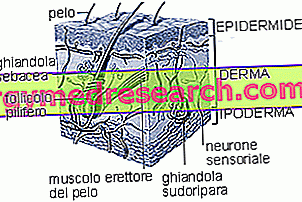Key points
Necrotizing fasciitis is a serious, violent and sudden infection of soft tissues, with a predominantly bacterial etiology.
Necrotizing fasciitis: causes
The bacteria most involved in necrotizing fasciitis are: group A hemolytic streptococcus β, staphylococci (especially Staphylococcus aureus ), anaerobes belonging to the genus Clostridium, Vibrio parahaemolyticus, Vibrio vulnificus, Aeromonas hydrophila.
Necrotizing fasciitis: symptoms
The most common signs and symptoms in necrotizing fasciitis include: skin redness, chills, weakness, diarrhea, limited pain, edema, fever, bruises, tissue necrosis, shock, sweating, vomiting. If left untreated, tissue necrosis gives poor prognosis.
Necrotizing fasciitis: therapy
The therapy for necrotizing fasciitis must be immediate and consists in the administration of antibiotics at high doses and in surgical excision of the infected tissues. Intensive supportive therapy and the hyperbaric chamber are also useful.
Definition
Fortunately rare, necrotizing fasciitis is a severe soft tissue infection, usually caused by toxigenic bacteria. Necrotizing fasciitis affects the deeper layers of the skin, rapidly spreading subcutaneous soft tissue through the superficial and deep fascia.
- Each deep soft tissue compartment - dermis, subcutaneous tissue, muscle bundles - is a possible target of this potentially deadly infection. However, necrotizing fasciitis has a marked predilection for lower limbs, perineum and abdominal wall.
Necrotizing fasciitis is a sudden onset disease that must be treated as soon as possible with high doses of intravenous antibiotics.
Necrotizing fasciitis is also known by many other names, which immediately make the infection severe: gangrenous acute cellulite , meat-eating disease, meat-eating bacteria syndrome . Based on the location of the infection, necrotizing fasciitis takes on different names: Fournier's gangrene (necrotizing fasciitis of the scrotum and vulva) and Ludwig's angina (necrotizing fasciitis of the submandibular space).
Necrotizing fasciitis is a very rare infection but has a very high mortality rate.
Causes and classification
Necrotizing fasciitis is caused by bacterial (mainly) and fungal (rare) infections.
From the etiopathological point of view, various different entities are recognized:
- TYPE I NECROTIINTING FASTS: polymicrobial infection caused mainly by type A streptococci ( Streptococcus pyogenes ), C and G. This form of necrotizing fasciitis particularly affects immunocompromised or chronically ill patients.
- TYPE II NECROTIZING FASTS: monomicrobial infection, in particular carried by group A streptococcus, staphylococci or anaerobes belonging to the genus Clostridium (eg Clostridium perfringens ). Methicillin-resistant Staphylococcus aureus (MRSA) is also involved in this variant of necrotizing fasciitis.
- TYPE III NECROTIZANT FASTS: serious infections carried by marine microorganisms, such as Vibrio parahaemolyticus, Vibrio vulnificus and Aeromonas hydrophila . People with liver disease are the most sensitive to this form of necrotizing fasciitis: these infections are particularly virulent and deadly (if not treated promptly, death occurs within 48 hours of the first symptoms appearing).
- TYPE IV NECROTIINTING FASTS: fungal infections. Patients suffering from traumatic wounds or burns are more at risk of contracting Zigomycetes infections; the immunocompromised are more exposed to the fungal infections sustained by Candida albicans .
From medical statistics, it is clear that necrotizing fasciitis occurs more often in some categories of patients: diabetics, drug addicts, alcoholics, patients with vascular diseases and immunocompromised in general. Other risk factors include: tuberculosis, malignant neoplasms, Herpes zoster infections (the virus responsible for chickenpox and S. Antonio fire).
However, healthy subjects are not out of the disease.
Symptoms
The symptoms of necrotizing fasciitis generally appear in a few days. The symptomatic picture precipitates in 48 hours in patients infected with Vibrio spp . and Aeromonas hydrophila : in similar situations, death looms in a few hours.
In general, the symptoms of necrotizing fasciitis vary over time: the more the disease evolves, the more the symptoms get worse. Let's see in detail the course of the disease:
- In the first two days after infection, the patient complains of circumscribed and constant PAIN, ERYTHEMA and GONFIORE. This triad of symptoms is easily confused with the characteristic signs of erysipelas and infectious cellulite. The margins of the infection are not well defined and the particular "SOFTNESS" OF THE SKIN extends beyond the point of infection. During this phase, the disease does not respond to antibiotic treatment. Lymphangitis (inflammation of the lymphatic vessels) is rarely observed. Among other symptoms, we mention: TACHYCARDY, FEBRUARY, DEHYDRATION, DIARRHEA and VOMITING.
- After 2-4 days, the necrotizing fasciitis causes EDEMA, DIFFUSED ERYTEMA, BUBBLE LESIONS and bleeding. The skin, first flushed, takes on a greyish color, synonymous with necrosis. The cutaneous tissues are rigid and stretched to the touch, while the muscular bundles are no longer palpable. At this stage, many patients no longer perceive pain, since the necrotizing fasciitis is destroying the nerves.
- On the fourth / fifth day, the patient manifests HYPOTENSION, CONFUSION, APATIA and SEPTIC SHOCK.
If not promptly treated, necrotizing fasciitis is MORTAL for 73% of patients.
Diagnosis
The diagnosis of necrotizing fasciitis consists in the medical observation of the lesions. In case of suspected necrotizing fasciitis, the patient is subjected to CT, blood tests and biopsy of a portion of damaged tissue. In addition to the listed diagnostic techniques, an immediate exploratory surgery is often used, useful for both diagnostic and therapeutic purposes: after having ascertained the necrotizing fasciitis, a large portion of infected tissue is immediately removed. In the event that the infection spreads to the peripheral regions, the limb is amputated.
Differential diagnosis
Necrotising fasciitis is rather complex to diagnose in its early stages: this infectious form is often confused by bacterial cellulitis. The diagnostic delay postpones the therapy, consequently the risk of fatal outcome increases exaggeratedly. For the differential diagnosis it is important to focus on some parameters that, in infectious cellulite, are not very evident or even absent:
- Clear softness of the affected skin
- Exaggerated pain, which is accentuated to the touch
- Bubbles and ecchymoses on the skin, near the infection site
Therapy
Necrotizing fasciitis therapy includes:
- Surgical therapy: consists in removing flaps of infected tissue, up to amputation of the limb. Given the delicacy and complexity of the operation, the patient is generally subjected to several surgical procedures, possibly associated with a skin and tissue transplant.
- Administration of high dose antibiotics: antibiotic therapy is also indicated in cases of suspected necrotizing fasciitis. The therapy consists of a mix of antibiotics, of which penicillin, clindamycin and vancomycin seem the most effective.
- Intensive supportive therapy: useful for coping with hypotension, the body's violent inflammatory response and septic shock. Here, the patient suffering from necrotizing fasciitis is subjected to transfusion of liquids and blood.
- Hyperbaric oxygen therapy: therapy strategy indicated for all patients suffering from tissue destruction and extensive wounds.
Immediate intervention is necessary to prevent the fatal outcome of the patient suffering from necrotizing fasciitis.



